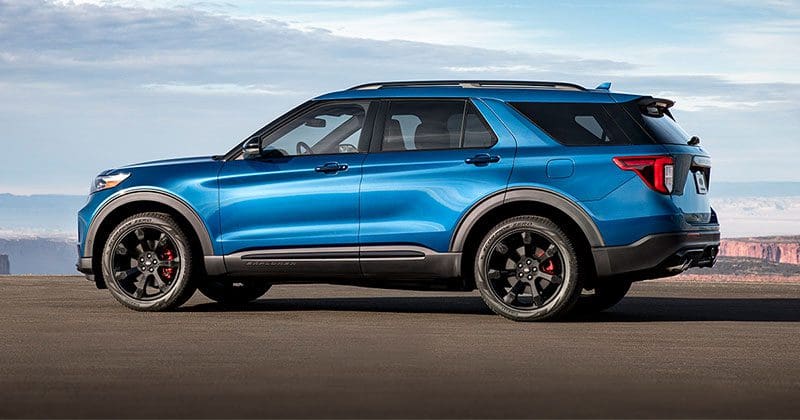When automotive enthusiasts think ST, they think of the two sport compact products that are legendary in the enthusiast world: the Ford Focus ST and the Fiesta ST. Both are wonderful compact sporting machines that help drivers bring out their inner Ken Block and rally car inclinations. With their built-in electronic driving aids, they can even help make mediocre drifters look good. The ST stands for Sport Technologies. But can the same sport technology be implemented in an Explorer? Does it even make sense?
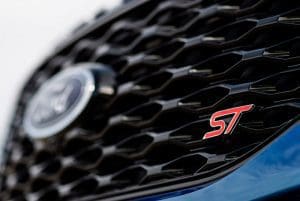 Well, Ford has done its research and shown the public there really is a need for a high-performance three-row SUV. The only other competitor in the segment is the aging Dodge Durango SRT. But where the Dodge does it with brute force (and dismal fuel economy), the Ford does it with a twin-turbocharged EcoBoost engine. Which can also drink fuel very fast when you are in the boost, but I was able to get over 20 mpg on a road trip. Not bad for a three-row SUV that can tow a boat and compete with Mustangs at the dragstrip.
Well, Ford has done its research and shown the public there really is a need for a high-performance three-row SUV. The only other competitor in the segment is the aging Dodge Durango SRT. But where the Dodge does it with brute force (and dismal fuel economy), the Ford does it with a twin-turbocharged EcoBoost engine. Which can also drink fuel very fast when you are in the boost, but I was able to get over 20 mpg on a road trip. Not bad for a three-row SUV that can tow a boat and compete with Mustangs at the dragstrip.
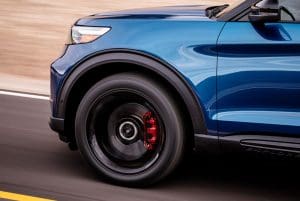 The engine is only 3 liters but flexes 400 horsepower. Compared with the original 155 horsepower Explorer, that sounds nuts. Especially when you consider that it’s coupled to a 10-speed automatic transmission to make the most of the power. The result is an impressive kick in the pants, especially when you dial the selector behind the rotary selector into Sport mode. The other modes are Normal, Slippery, Trail, Deep Snow/Sand, Tow/Haul and Eco. My only complaint is that the gear selector, drive mode selector and volume control are all rotary dials. It can get confusing if you’re in a hurry.
The engine is only 3 liters but flexes 400 horsepower. Compared with the original 155 horsepower Explorer, that sounds nuts. Especially when you consider that it’s coupled to a 10-speed automatic transmission to make the most of the power. The result is an impressive kick in the pants, especially when you dial the selector behind the rotary selector into Sport mode. The other modes are Normal, Slippery, Trail, Deep Snow/Sand, Tow/Haul and Eco. My only complaint is that the gear selector, drive mode selector and volume control are all rotary dials. It can get confusing if you’re in a hurry.
The new Explorer platform is an improvement over the old model. Craig Patterson, Ford SUV marketing manager notes, “A vehicle like Explorer can’t just be good-looking. Explorer customers need it to do certain things. They need to be able to drive certain places and haul specific items. This Explorer performs no matter what adventures you have in store.”
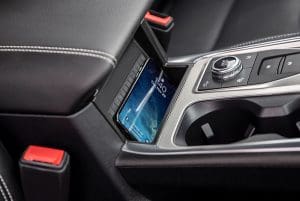 The cabin is a nice place to be. I especially like the additional smartphone holder locations strewn about. There’s even a wireless Qi charging pad tucked on the back on the center console. It works great because your phone is in reach, but you aren’t tempted to look at it while you’re driving. Instead, it passes that interactivity task off to the SYNC 3 infotainment system. Your aftermarket mobile electronics shop can add Qi capability if you have an earlier Explorer or another type of vehicle. It’s a great upgrade.
The cabin is a nice place to be. I especially like the additional smartphone holder locations strewn about. There’s even a wireless Qi charging pad tucked on the back on the center console. It works great because your phone is in reach, but you aren’t tempted to look at it while you’re driving. Instead, it passes that interactivity task off to the SYNC 3 infotainment system. Your aftermarket mobile electronics shop can add Qi capability if you have an earlier Explorer or another type of vehicle. It’s a great upgrade.
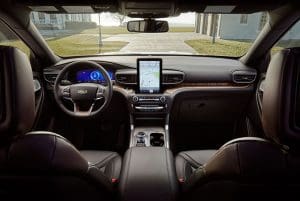 The centerpiece of the cabin is the portrait-mounted 10.1-inch infotainment screen that takes a page from Volvo and Tesla. The clarity of the screen is great. The ability is there to have one half of the split screen display navigation and the other half show audio information. But if you already know where you’re going, the audio screen has wasted real estate. It would be great if the presets would automatically center themselves in audio-only screen mode instead of hiding at the bottom of the display. The point of a massive display is to make locating features easy. But once your audio is dialed in, it plays through a Bang & Olufsen system that flexes 980 watts of power. It sounds OK, but not like 980 watts of aftermarket power.
The centerpiece of the cabin is the portrait-mounted 10.1-inch infotainment screen that takes a page from Volvo and Tesla. The clarity of the screen is great. The ability is there to have one half of the split screen display navigation and the other half show audio information. But if you already know where you’re going, the audio screen has wasted real estate. It would be great if the presets would automatically center themselves in audio-only screen mode instead of hiding at the bottom of the display. The point of a massive display is to make locating features easy. But once your audio is dialed in, it plays through a Bang & Olufsen system that flexes 980 watts of power. It sounds OK, but not like 980 watts of aftermarket power.
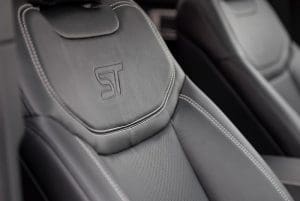 One cool safety feature of the new Explorer is that it can be equipped with Ford’s intelligent adaptive cruise control with speed sign recognition. Like other adaptive cruise systems, a speed can be set manually and the vehicle will slow automatically if the vehicle in front slows. Ford’s new system will also adjust speeds by reading highway speed limit signs. It makes sense in a vehicle that has 400 horsepower. The first time it happened while I was driving, I was wondering why the adaptive cruise control system was slowing down when there was no vehicle in front of me. The Explorer had detected the road sign in an upcoming work zone. Ford does offer the ability to choose an offset speed limit. The driver can choose to always set the speed 5 mph more than the posted limit when using adaptive cruise control. The offset can be as much as 10 mph more or less than the posted speed.
One cool safety feature of the new Explorer is that it can be equipped with Ford’s intelligent adaptive cruise control with speed sign recognition. Like other adaptive cruise systems, a speed can be set manually and the vehicle will slow automatically if the vehicle in front slows. Ford’s new system will also adjust speeds by reading highway speed limit signs. It makes sense in a vehicle that has 400 horsepower. The first time it happened while I was driving, I was wondering why the adaptive cruise control system was slowing down when there was no vehicle in front of me. The Explorer had detected the road sign in an upcoming work zone. Ford does offer the ability to choose an offset speed limit. The driver can choose to always set the speed 5 mph more than the posted limit when using adaptive cruise control. The offset can be as much as 10 mph more or less than the posted speed.
The new Ford Explorer is a welcome addition to the ultra-competitive three-row SUV class. If you’re looking for an SUV that adds sport to the equation, check out the Explorer ST. After all, just because soccer moms drive Explorers does not mean you have to be one!
